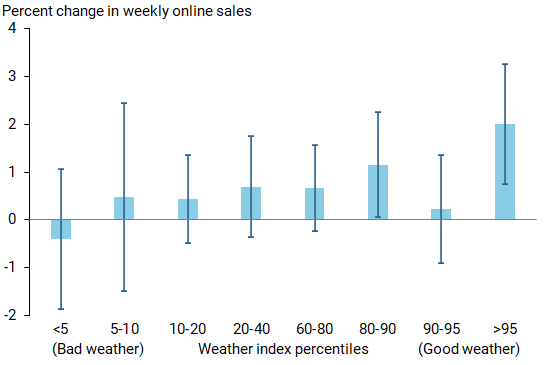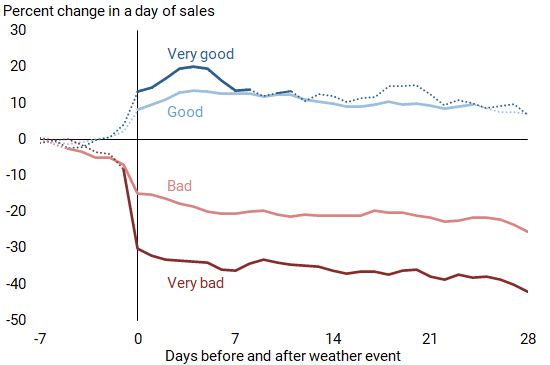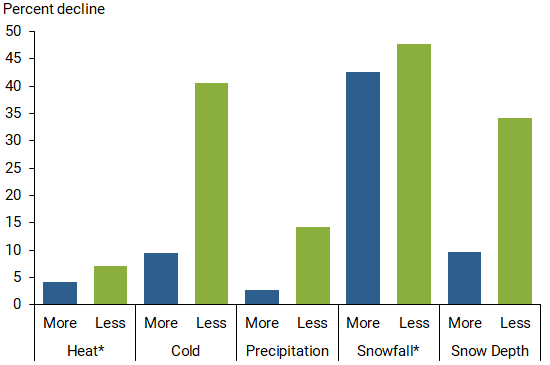Variation in weather could cause greater disruptions to a range of economic outcomes as severe weather events become more frequent or more extreme. Analyzing daily sales at a national apparel and sporting goods brand’s stores reveals that weather effects on store sales are surprisingly persistent, even after accounting for shoppers simply changing when and where they make their purchases. Moreover, sales at stores that have more experience with adverse weather events have a lower response, suggesting that adaptation may reduce the negative impact of increasingly severe weather on sales.
Recent years have seen an increase in global temperatures and the frequency of severe weather. This can increase volatility in various economic activities, particularly to the extent that immediate responses to weather shocks are not reversed over time. Research has shown that weather affects a wide range of economic activities, including retail sales through various channels. It can affect the ease of physically getting to stores as well as the desirability of shopping relative to other activities. Weather can also affect the underlying demand for particular goods. Prior studies have documented significant effects of weather on aggregate retail activity; however, it remains unclear whether the effects are persistent or represent timing shifts (see Starr-McCluer 2000, Bloesch and Gourio 2015, Boldin and Wright 2015, and Wilson 2017).
In this Economic Letter, based on my research in Roth Tran (2022), I apply a novel methodology to examine a national sporting goods and apparel brand’s daily store-level sales at over 100 of its stores. I show that only a small share of immediate responses of store sales to weather are offset over time or through other channels. I then show that the sensitivity of sales to some severe weather events decreases with historical local experience with those events, a sign of potential adaptation to severe weather arising from a changing climate.
Modeling weather
Weather consists of multiple dimensions, including temperature, rain, and snow. What makes for “good” or “bad” weather for a particular retail store depends on contextual elements like store type (indoor or outdoor), location (for example, Miami versus Boston), and time of year. For example, an unusually warm day in winter could be a bad day for shopping in an indoor mall in the Northeast, as people might rather spend the time outside. However, a very hot day in summer could make an air-conditioned indoor mall a very appealing place to spend time. Similarly, while a small amount of rain on a warm day might make shopping relatively attractive, a large amount of rain or a small amount when it is freezing cold outside could convince people to stay home. What constitutes relatively small and large amounts of rain also varies by region.
The sales data I use allow me to examine weather effects across a range of contexts. Representing over 100 stores across the United States from April 2010 to December 2013, the data span a wide range of climates and weather outcomes. I identify each store as indoor or outdoor based on whether patrons can move between stores in a shopping center without being exposed to weather. Daily weather station data from NOAA (National Oceanic and Atmospheric Administration) provide maximum and minimum temperatures, precipitation, snowfall, and snow depth.
I apply machine learning methodology to develop a weather index that collapses myriad dimensions into a one-dimensional measure of how favorable weather conditions are for sales at a given store on a particular day. The index uses zero as the average and a standard deviation of one. A higher value reflects weather conditions that are more favorable for sales. By indicating how good or bad weather is for sales, the weather index both reduces the dimensionality of weather and captures the aspects of weather that matter to specific stores at specific times, which makes it easier to estimate the dynamic effects of weather shocks.
Offsetting immediate responses of sales to weather
Weather may largely affect retail sales by changing the experience of shopping or the ability to get to stores, rather than changing demand for particular products. In this case, the immediate response of sales at a given store on a given day may be offset by shifts over time or across venues and platforms for the retail firm as a whole. Although weather could still increase variability in daily sales at individual stores, these sorts of shifts would reduce the net overall effect of weather on retail sales. I examine three potential channels through which immediate responses of retail store sales to weather can be offset: shifting of sales from physical stores to the firm’s website, shifting of sales between stores in indoor and outdoor shopping centers, and shifting of sales over time.
Figure 1 explores the first channel by showing the average percent changes in weekly online sales in response to weather. It shows that online sales do not offset immediate effects of weather on store sales. When the weather is bad for sales at stores, indicated by a low weather index value, online sales are not significantly affected. When weather is good for shopping in stores, indicated by a high weather index value, online sales actually increase. This latter finding could be explained by weather affecting underlying demand for particular products or if shopping in stores leads to online orders for specific sizes or colors of products that are not in stock. More details are available in Roth Tran (2022).
Figure 1
Responses of online sales to weather

Note: Ranges on the horizontal axis reflect percentiles of weather index values; low values reflect bad weather for in-store sales, high values reflect good weather for in-store sales. Percent changes in weekly sales apply to local, not aggregate sales. Dark blue bars indicate 95% confidence intervals.
Turning to the second offsetting channel, weather can affect how much people enjoy the experience of shopping relative to other activities. For example, a shopping trip to an air-conditioned enclosed mall might be a relatively pleasant activity on a hot or rainy day. On a more pleasant day, people might enjoy shopping at outdoor malls. If the choice of shopping environment is based on weather, weather events may cause some shifting of sales between indoor and outdoor stores.
I find that, on average, only a small share of immediate responses of store sales to weather appear to be offset by shifting between indoor and outdoor stores. Although precipitation shifts some sales from outdoor to indoor shopping centers, responses of sales to events like snowfall—which leads to large declines in sales at both indoor and outdoor stores—account for a much larger share of weather effects on sales.
Turning to the last offsetting channel, I look at whether immediate responses of sales to weather are offset over time. For example, although demand for sporting goods and apparel products could be more weather sensitive than other goods, these are items for which the weather is likely to be good at some point in the future.
Figure 2 reports the effects of weather events on sales over time. The lines report average estimates for each category, with the solid portions reflecting that the estimates fall within the 95% confidence range for statistical significance; the dotted lines show estimates that are not statistically different from zero.
Figure 2
Cumulative responses of sales to weather over time

Note: Vertical zero line indicates the day of the weather event. Solid portions of lines indicate statistical significance; dotted portions indicate the estimates for those days are not statistically significant within a 95% confidence interval.
The blue lines show that the immediate effects of good weather may be offset at least in part by subsequent decreases in sales, as indicated by the fact that the responses are no longer statistically significant by four weeks after the weather event. In contrast, the red lines show that the responses of sales to bad weather are persistent. For example, a moderately bad weather day yields a net decrease of about one-quarter of a day’s sales, while a very bad weather day yields an average net loss of about 40% of a day’s sales. Note that these estimates exclude days when the weather is so severe that stores are closed. Taken together, these results suggest that, while the initial boost to sales from good weather may be offset in the ensuing weeks, the immediate losses from bad weather are persistent and not offset over time.
Adaptation and future implications
Stores, shoppers, and communities can adapt to the changes in their climates by investing in physical and human capital like umbrellas, coats, air conditioners, snowplows, and skills for driving in adverse weather. Investments like these can decrease the sensitivity of outcomes to particular weather events.
To test for adaptation, I estimate whether the sensitivity of sales to certain weather events is lower in areas that have more historic experience with those events. Specifically, I use weather data from 1980–2009 to divide stores into two groups for each weather event: those with more (above median) historical experience with the event and those with less (below median) historical experience with it. I then jointly estimate the responses to the weather events for the two groups of stores.
Consistent with adaptation, Figure 3 shows that sensitivities to some weather events decrease with historical experience with those events. On days when maximum temperatures are below 0˚C, precipitation exceeds 2 inches, and snow depth is above 2 inches, sales declines are much larger at stores with less prior historical experience with those events. For example, the average decline in sales when precipitation exceeds 2 inches is about 80% less for stores in areas with above-median historical experience of more than 2 inches precipitation than for stores in areas with below-median historical experience.
Figure 3
Sensitivity to severe weather based on past experience

Note: A store is designated as more experienced if the historical frequency of that event is above the median historical frequency across all stores. Heat refers to days when average temperatures exceed of 90˚F (32˚C) and cold is when maximum temperature is below 32˚F (0˚C). Precipitation, snowfall, and snow depth refer to days when these measures are at least 2 inches.
*For heat and snowfall, the differences in the responses between the more and less experience categories are not statistically significant.
In contrast to precipitation and snow, I do not find that sensitivity to extreme heat decreases with experience. This could be explained by extreme heat decreasing the underlying demand for sporting goods and apparel. Although people can adapt by using some sporting goods indoors in air conditioning, physiological limits to our capacities to adapt to extreme heat may limit the demand for goods specifically meant for outdoor use. This is supported by other research showing that people spend less time outdoors during extreme heat (see Graff Zivin and Neidell 2014).
Conclusion
Analysis in this Letter shows that severe weather can have significant impacts on store sales, even when accounting for potential channels through which the immediate effects could be offset. Consistent with adaptation, experience with some weather events reduces sensitivity of sales to those events. On the one hand, this suggests that the potential impact on retail sales of increasingly severe weather—one dimension of climate risk—could be smaller than current responses would indicate. On the other hand, as severe weather increasingly occurs in areas less experienced with it, the average current responses may understate how disruptive weather may be.
Brigitte Roth Tran is an economist in the Economic Research Department of the Federal Reserve Bank of San Francisco.
References
Bloesch, Justin, and François Gourio. 2015. “The Effect of Winter Weather on U.S. Economic Activity.” FRB Chicago Economic Perspectives 39(1).
Boldin, Michael, and Jonathan H. Wright. 2015. “Weather-Adjusting Economic Data.” Brookings Papers on Economic Activity 2015(2), pp. 227–278.
Graff Zivin, Joshua, and Matthew Neidell. 2014. “Temperature and the Allocation of Time: Implications for Climate Change.” Journal of Labor Economics 32(1), pp. 1–26.
Roth Tran, Brigitte. 2022. “Sellin’ in the Rain: Weather, Climate, and Retail Sales.” FRB San Francisco Working Paper 2022-02.
Starr-McCluer, Martha. 2000. “The Effects of Weather on Retail Sales.” Federal Reserve Board, Finance and Economics Discussion Series paper 2000-08.
Wilson, Daniel J. 2017. “The Impact of Weather on Local Employment: Using Big Data on Small Places.” FRB San Francisco Working Paper 2016-21.
Opinions expressed in FRBSF Economic Letter do not necessarily reflect the views of the management of the Federal Reserve Bank of San Francisco or of the Board of Governors of the Federal Reserve System. This publication is edited by Anita Todd and Karen Barnes. Permission to reprint portions of articles or whole articles must be obtained in writing. Please send editorial comments and requests for reprint permission to research.library@sf.frb.org
